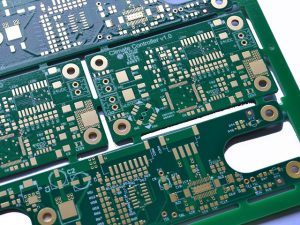
When it comes to printed circuit boards (PCBs), the thickness of the copper used in their construction is an important factor to consider. Copper thickness is typically measured in ounces, with common options including 1oz and 2oz copper. But what exactly does this measurement mean, and how does it affect the performance of a PCB?
In this post, we’ll compare 1oz and 2oz copper PCBs to help you understand the key differences between these two options. By the end, you should have a good sense of which type of copper PCB is best suited to your needs.
What is Copper Thickness in PCBs?
In a PCB, the copper layer refers to the thin sheets of copper foil that are laminated onto a substrate material, such as fiberglass or plastic. These copper layers serve as the “wiring” for the PCB, carrying electrical signals from one component to another.
The thickness of the copper used in a PCB is measured in ounces (oz), with 1oz and 2oz being the most common options. But what does this measurement actually mean?
To put it simply, the weight of the copper in a PCB is measured in ounces, and the resulting measurement is referred to as the PCB’s copper thickness. So, for example, a PCB with 1oz of copper will have a layer of copper that weighs 1oz, while a PCB with 2oz of copper will have a layer that weighs 2oz.
But why does copper thickness matter in PCBs? One important reason is that it affects the PCB’s electrical conductivity. In general, the thicker the copper layer, the better the electrical conductivity will be. This is because a thicker layer of copper provides more surface area for the electrical current to flow through, reducing resistance and improving overall performance.
Copper thickness is also relevant when it comes to heat dissipation in PCBs. Copper is an excellent conductor of heat, so a thicker layer of copper can help to dissipate heat more effectively. This can be especially important in applications where the PCB is expected to generate a lot of heat, such as in high-power electronic devices.
1oz Copper PCBs
Now that we’ve discussed the basics of copper thickness in PCBs, let’s delve into the specific properties of 1oz copper PCBs.
A 1oz copper PCB has a layer of copper that weighs 1oz, or 28.35 grams. This is a relatively thin layer of copper, and as such, 1oz copper PCBs tend to have lower electrical conductivity compared to PCBs with thicker copper layers.
However, there are still plenty of applications where 1oz copper PCBs are a good choice. For one thing, they are typically less expensive to manufacture than PCBs with thicker copper layers. This is because less copper is used, which reduces the material costs.
1oz copper PCBs are also lighter in weight than PCBs with thicker copper layers, which can be an advantage in certain applications where weight is a concern (e.g. in aircraft or spacecraft). Additionally, 1oz copper PCBs tend to be more flexible than PCBs with thicker copper layers, which can be useful in certain types of designs.
On the downside, 1oz copper PCBs may not be the best choice for applications that require high levels of electrical conductivity or heat dissipation. They may also be more prone to issues with signal integrity, as the thinner copper layer can be more susceptible to interference from other signals.
2oz Copper PCBs
In contrast to 1oz copper PCBs, 2oz copper PCBs have a layer of copper that weighs 2 times as much, or 56.7 grams. This thicker layer of copper results in improved electrical conductivity and heat dissipation compared to 1oz copper PCBs.
The increased electrical conductivity of 2oz copper PCBs can be especially beneficial in high-power applications, as it allows for larger currents to be carried without issues. The improved heat dissipation can also be useful in applications where the PCB is expected to generate a lot of heat, as the thicker layer of copper can more effectively dissipate that heat.
However, there are also some potential drawbacks to using 2oz copper PCBs. One is cost: because more copper is used, these PCBs tend to be more expensive to manufacture than 1oz copper PCBs. They are also typically heavier than 1oz copper PCBs, which can be an issue in applications where weight is a concern. Additionally, 2oz copper PCBs may be more rigid and less flexible than 1oz copper PCBs.
Comparison: 1oz vs 2oz Copper PCBs
So, which type of copper PCB is best for your needs: 1oz or 2oz? The answer will depend on the specific requirements of your application.
If cost is a primary concern, then 1oz copper PCBs may be the better choice, as they tend to be less expensive to manufacture. They are also lighter in weight and more flexible than 2oz copper PCBs, which could be an advantage in certain situations. However, if electrical conductivity and heat dissipation are key considerations, then 2oz copper PCBs may be a better option, as they offer improved performance in these areas.
Ultimately, the decision of whether to use 1oz or 2oz copper PCBs will depend on the specific needs of your application. By considering factors such as cost, weight,PCB factories, flexibility, and electrical and thermal performance, you can determine which type of copper PCB is the best fit for your project.
Conclusion
In this post, we’ve compared 1oz and 2oz copper PCBs to help you understand the key differences between these two options. We’ve discussed the properties of 1oz and 2oz copper PCBs, including their electrical conductivity, heat dissipation, cost, weight, and flexibility. We’ve also outlined the circumstances under which one type of copper PCB might be preferred over the other.
By considering the specific requirements of your application, you can determine which type of copper PCB is the best fit for your project. Whether you choose 1oz or 2oz copper PCBs, understanding the trade-offs associated with each option can help you make an informed decision.




